Images of dry tropical habitat: Madagascar II
Click on a thumbnail for a larger
image. The thumbnails are arranged into 2 categories: Plants (and a fungus),
and Animals. The number by each photo corresponds to its caption below
.
Plants (and a fungus)
1.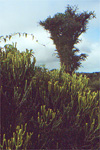 2.
2. 3.
3. 4.
4. 5.
5.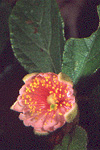 6.
6. 7.
7.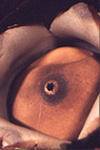 8.
8.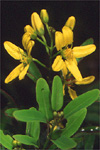 9.
9. 10.
10.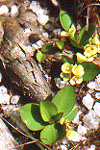 11.
11.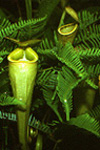 12.
12. 13.
13.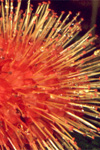 14.
14.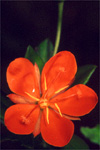 15.
15.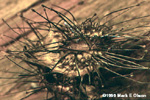
- 1. Madagascar is full of strange
plants. The plant in the foreground is one of the coralliform Euphorbias
that are so diverse on the island, so named because the odd branching
of the stems reminded early botanists of corals.The tree in the background
is Alluaudia comosa (Didieriaceae). Photographed near Tulear in
the southwest.
- 2. Alluaudia comosa
near Tulear. This strange tree has branches that are very thick at
the base and then taper almost immediately to fine, spiny branchlets.
Tulear's landmark plateau La Table can be seen in the background.
- 3. Bismarckia palms
on the plains in the Isalo area, in the southern central part of the
island.
- 4. Flower of Phylloctenium,
a prickly shrub in the Bignoniaceae family. This one was
found in the Mikea Forest on the southern part of the west coast.
- 5. and 6. Flower and
fruit of Grewia sp. (Malvaceae), an important component of dry
vegetation in Madagascar and other parts of the Old World. This was found
in the Mikea Forest.
- 7. Earthstar fungus
from the Mikea forest.
- 8. Flowers of a
plant in the Malpighiaceae from the Mikea Forest.
- 9. The spiny
branches of Azima tetracantha (Salvadoraceae), photographed on
the west coast.
- 10. A low-growing
tuberous Euphorbia growing among the quartz in southern central
Madagascar.
- 11. Nepenthes
madagascariensis (Nepenthaceae), a carnivorous pitcher plant, and
the fern Gleichenia (Gleicheniaceae)growing in a seep in the southeast.
- 12. The
fat-bellied bottle palm Dypsis decipiens groing in the central
southern part of the island.
- 13. The
dense inflorescence of the liana Combretum (Combretaceae) is borne
directly on the trunk near the ground. This one was photographed in dry
forest in the Ankarana Reserve in northern Madagascar.
- 14.
Another view of Erblichia (Turneraceae) from Ankarana.
Look at the brush- like stigmas!
-
15. The fruit of this Uncarina species from northern Madagascar
is covered with very sharp miniature grappling hooks. Uncarina
is in the Sesame Family (Pedaliaceae).
-
Animals
1.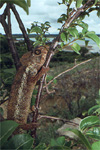 2.
2.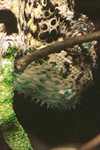 3.
3.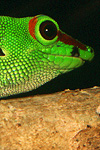 4.
4. 5.
5. 6.
6. 7.
7.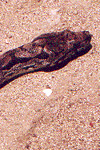 8.
8. 9.
9.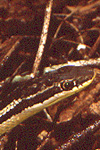 10.
10.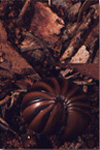
-
1. Furcifer oustaleti, a common chameleon in northern dry areas.
-
2. Furcifer verrucosus is common in parts of the south. It bears
striking white, black, green, and turqoise spots when alarmed.
-
3. - 5. Phelsuma geckos are a perfect example of how Madagascar
is different from other parts of the world. In most places, lizards in
the gecko family are active at night. Phelsuma geckos are active
in the day. Geckos from other areas for the most part have colors that
blend in well with their surroundings. Phelsuma geckos are often
blazingly bright colors, such as 3. and 4., Phelsuma madagascariensis,
photographed in the far north.
. 5. is Phelsuma mutabilis. It can change color very quickly.
When I found this one in the southeast, it was bright green and turquoise.
After it saw me, it quickly lost these bright colors.
-
6. Madagascar is wonderful for its lack of snakes poisonous enough to
be dangerous to people. This is Mimophis mahafalensis from the
southeast (thanks to Chris Raxworthy for the ID!).
-
7. Acrantophis dumerilii, a boa from the dry south.
-
8. A Leioheterodon geayi eating a Chalarodon lizard in
the Mikea Forest.
-
9. Dromicodryas bernieri in the Mikea Forest.
-
10. A "pill millipede" from the southeast. These short, fat millipedes
act just like sowbugs: when alarmed, they curl up in tight balls!
home - people -
research - images of the dry
tropics - exploration
-
acknowledgements
Instituto de Biología, Universidad Nacional Autónoma
de México
Circuito Exterior s/n, Ciudad Universitaria
Copilco, Coyoacán A. P. 70-367
C. P. 04510, México, D. F.
MÉXICO
(52) 55 5622-9127 fon (52) 55 5555-1760 fax
molson@ibiologia.unam.mx
all material © 2002 Mark E Olson
except Euphorbia and Dypsis
which are ©1999 Simon T Malcomber
 2.
2. 3.
3. 4.
4. 5.
5. 6.
6. 7.
7. 8.
8. 9.
9. 10.
10. 11.
11. 12.
12. 13.
13. 14.
14. 15.
15.
 2.
2. 3.
3. 4.
4. 5.
5. 6.
6. 7.
7. 8.
8. 9.
9. 10.
10. 11.
11. 12.
12. 13.
13. 14.
14. 15.
15.
 2.
2. 3.
3. 4.
4. 5.
5. 6.
6. 7.
7. 8.
8. 9.
9. 10.
10.